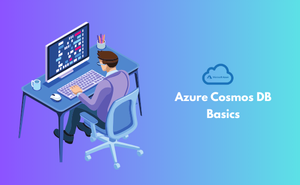👇 CELEBRATE CLOUD SECURITY DAY 👇
00
HOURS
00
MINUTES
00
SECONDS

Azure Cosmos DB is a cloud-based database solution from Microsoft that’s built for speed, scalability, and global reach. It allows companies to store data across different geographic regions while ensuring quick response times. Unlike traditional databases, Cosmos DB automatically adjusts resources to meet demand, which makes it a powerful choice for apps needing continuous availability.
For teams building modern applications, Cosmos DB simplifies data handling by offering flexible models, automatic scaling, and guaranteed uptime. It’s widely used in scenarios like personalized shopping, fraud detection, online gaming, and any system where real-time access to large volumes of data is critical.
This exam is ideal for:
Domain 1 - Introduction to Azure Cosmos DB
Domain 2 - Cosmos DB Architecture
Domain 3 - Working with Data Models
Domain 4 - Consistency Models
Domain 5 - Performance and Scaling
Domain 6 - Integration with Azure Services
Domain 7 - Security and Compliance
Industry-endorsed certificates to strengthen your career profile.
Start learning immediately with digital materials, no delays.
Practice until you’re fully confident, at no additional charge.
Study anytime, anywhere, on laptop, tablet, or smartphone.
Courses and practice exams developed by qualified professionals.
Support available round the clock whenever you need help.
Easy-to-follow content with practice exams and assessments.
Join a global community of professionals advancing their skills.
Developers, data engineers, and architects working on cloud-based applications.
Basic familiarity with Azure cloud concepts is helpful.
Not strictly, but knowing SQL helps since Cosmos DB supports SQL API.
Retail, finance, gaming, IoT, and healthcare.
No, it’s designed for NoSQL and real-time use cases, not all relational scenarios.
No, startups and mid-sized companies also benefit from its scalability.
Yes, including SQL, MongoDB, Cassandra, Gremlin, and Table APIs.
Yes, data model design and querying are key parts of the course.
Yes, Microsoft offers SLAs with high availability guarantees.
Yes, it integrates with AI pipelines for real-time analytics.
Python, .NET, Java, JavaScript, and more.
Yes, topics include encryption, RBAC, and compliance.
It replicates data automatically across multiple regions.
Roles like cloud developer, data engineer, or solution architect become more accessible.
Yes, demand for globally distributed, real-time databases is rapidly increasing.